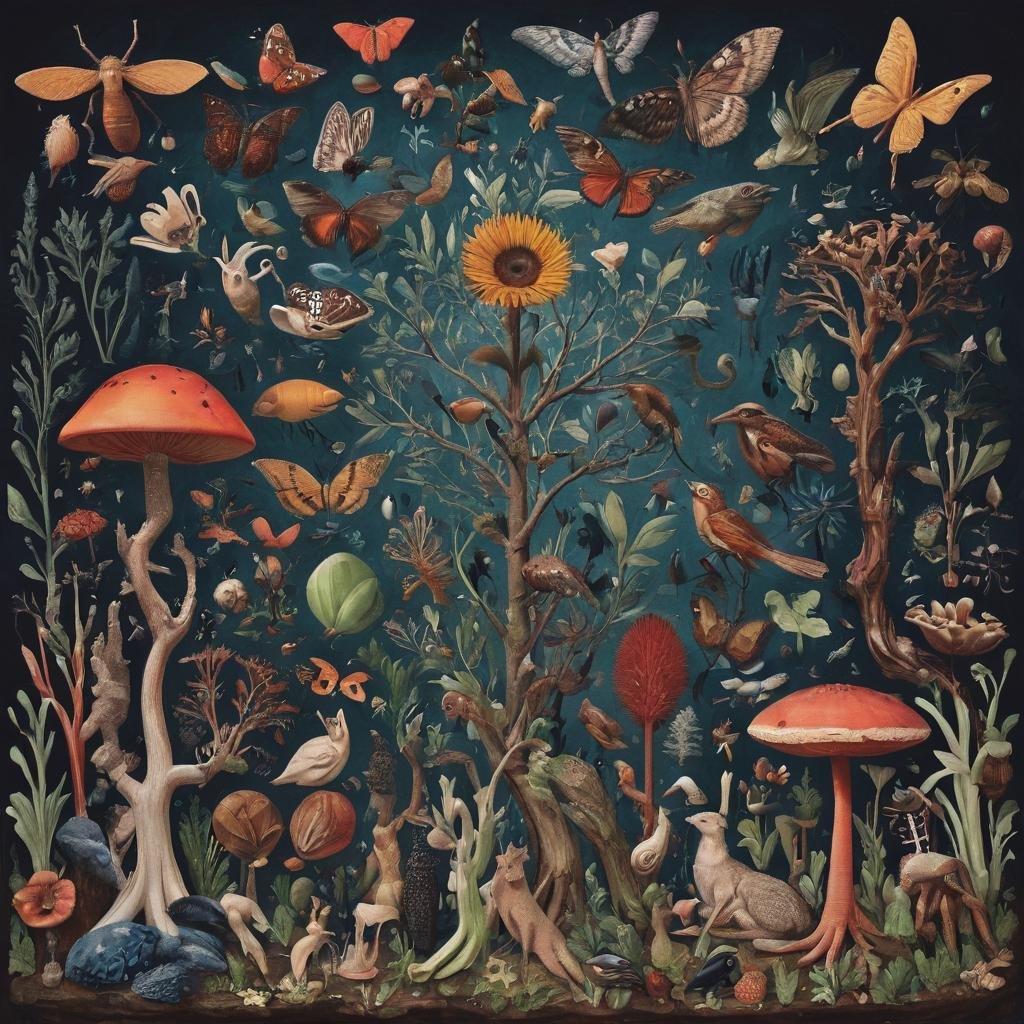
B2 First (FCE) Materials I’ve made; Please help yourself.
Biodiversity, or biological diversity, refers to the variety of life forms on Earth, encompassing everything from microbes to plants to animals. It is a measure of the health and resilience of ecosystems and plays a crucial role in supporting human well-being. Biodiversity provides essential ecosystem services such as pollination, water purification, and carbon sequestration, which are vital for agriculture, clean water supply, and climate regulation.
Biodiversity is essential for maintaining ecosystem balance and stability. It promotes ecosystem resilience, which is the ability of an ecosystem to withstand and recover from disturbances. High biodiversity levels make ecosystems more adaptable to environmental changes, such as climate change or natural disasters.
One of the most critical ecosystem services provided by biodiversity is pollination. Pollinators such as bees, butterflies, birds, and bats play a crucial role in pollinating flowering plants, including many crops that humans rely on for food. Without pollinators, many plant species would not be able to reproduce, leading to a decline in food production and loss of biodiversity.
Additionally, biodiversity is essential for water purification. Wetlands, forests, and other ecosystems act as natural filters, removing pollutants and sediments from water bodies. This helps to maintain water quality and ensures a clean water supply for human consumption and other uses.
Furthermore, biodiversity plays a vital role in carbon sequestration, the process by which carbon dioxide is removed from the atmosphere and stored in vegetation, soil, and oceans. Forests, mangroves, and other ecosystems absorb large amounts of carbon dioxide, helping to mitigate climate change by reducing greenhouse gas emissions.
Despite its importance, biodiversity is facing unprecedented threats due to human activities such as habitat destruction, pollution, overexploitation of natural resources, and climate change. These threats are causing species extinctions at an alarming rate, leading to a loss of biodiversity and ecosystem degradation.
Conserving biodiversity requires urgent action at both local and global levels. Efforts to protect and restore natural habitats, establish protected areas, promote sustainable land and resource management practices, and raise awareness about the importance of biodiversity are crucial steps in safeguarding the planet's rich diversity of life for future generations.
Questions:
What is biodiversity, and what does it encompass?
Why is biodiversity important for ecosystems?
Explain the concept of ecosystem resilience and its relationship to biodiversity.
How do pollinators contribute to biodiversity and human well-being?
What role does biodiversity play in water purification?
Describe the process of carbon sequestration and the role of biodiversity in it.
What are some threats to biodiversity mentioned in the passage?
What actions can be taken to conserve biodiversity?
Why is biodiversity conservation important for future generations?
In your opinion, what role do individuals, communities, and governments play in preserving biodiversity?
Contact me today for more materials and to start lessons together.
Reading Comprehension: The Benefits of TravelLing
Travelling is more than just visiting new places; it is a transformative experience that offers a myriad of benefits to individuals. From broadening perspectives to promoting personal growth, travelling enriches lives in numerous ways.
First and foremost, travelling exposes people to diverse cultures, customs, and traditions. By immersing themselves in unfamiliar environments, travellers gain a deeper understanding of the world's cultural diversity. This exposure fosters empathy, tolerance, and appreciation for different ways of life, contributing to a more interconnected and harmonious global community.
Moreover, travelling provides opportunities for self-discovery and personal growth. Stepping out of one's comfort zone and navigating unfamiliar territory fosters resilience, adaptability, and problem-solving skills. Travelers often encounter challenges and obstacles during their journeys, which compel them to learn and grow as individuals.
Travelling also stimulates creativity and inspiration. Experiencing new sights, sounds, and sensations ignites the imagination and sparks creativity. Many artists, writers, and innovators draw inspiration from their travels, incorporating elements of foreign cultures into their work and enriching their creative endeavours.
Furthermore, travelling promotes mental health and well-being. Taking a break from routine and experiencing new environments can alleviate stress, anxiety, and depression. Immersing oneself in nature or exploring vibrant cities can rejuvenate the mind and body, fostering a sense of relaxation and rejuvenation.
In addition to its personal benefits, travelling also contributes to economic growth and cultural exchange. The tourism industry generates revenue, creates jobs, and supports local economies in destinations around the world. Furthermore, interactions between travellers and locals facilitate cultural exchange and mutual understanding, fostering positive relationships and promoting peace and cooperation.
Overall, travelling is a transformative experience that offers numerous benefits to individuals and society as a whole. By broadening horizons, fostering personal growth, and promoting cultural exchange, travelling enriches lives and contributes to a more interconnected and harmonious world.
Questions:
According to the passage, what are some benefits of travelling?
How does travelling contribute to cultural understanding and appreciation?
What personal skills and qualities can be developed through travelling?
How does travelling stimulate creativity and inspiration?
In what ways does travelling promote mental health and well-being?
Explain the economic and cultural contributions of travelling mentioned in the passage.
Why is it important for individuals to step out of their comfort zones while travelling?
How can travellers contribute to local economies and communities?
What role does cultural exchange play in the benefits of travelling?
In your opinion, what are the most significant benefits of travelling, and why?
Reading Comprehension: The Impact of Climate Change on Polar Bears
Climate change poses a significant threat to polar bears, the iconic symbol of the Arctic. As temperatures rise and sea ice diminishes, polar bears face a myriad of challenges that threaten their survival.
First and foremost, polar bears rely on sea ice as their primary hunting platform to catch seals, their main source of food. However, with Arctic sea ice melting at an alarming rate, polar bears are forced to travel greater distances to find suitable hunting grounds. This increased travel not only expends more energy but also reduces their hunting success, leading to malnutrition and decreased reproductive rates.
Moreover, melting sea ice also limits the polar bear's ability to access important breeding and denning areas. Pregnant females typically seek out secluded areas on the ice to give birth and rear their cubs. However, with diminishing ice cover, these vital habitats are shrinking, leaving polar bears with fewer options for reproduction and survival.
Additionally, climate change exacerbates other threats to polar bear populations, such as pollution and human-wildlife conflict. As industrial activities increase in the Arctic, pollutants accumulate in the food chain, posing health risks to polar bears and other Arctic species. Furthermore, as sea ice retreats, polar bears are increasingly coming into contact with human settlements, leading to conflicts over resources and territory.
Despite these challenges, efforts to mitigate climate change and protect polar bear habitats offer hope for their conservation. Conservation initiatives focus on reducing greenhouse gas emissions, preserving critical habitat areas, and promoting sustainable coexistence between humans and polar bears.
In conclusion, climate change poses a grave threat to polar bears and their Arctic habitat. Without immediate action to address climate change and protect polar bear populations, these majestic creatures face an uncertain future.
Questions:
What are the primary threats to polar bears as a result of climate change?
How does the melting of sea ice affect polar bears' ability to hunt for food?
Why is access to breeding and denning areas crucial for polar bear reproduction?
How does climate change exacerbate other threats to polar bear populations?
What are some conservation efforts mentioned in the passage to protect polar bears?
What are the potential consequences of malnutrition and decreased reproductive rates among polar bears?
Why are polar bears considered an iconic symbol of the Arctic?
How do pollutants from industrial activities affect polar bear populations?
How do human settlements contribute to conflicts between humans and polar bears?
What do you think individuals and governments can do to help mitigate climate change and protect polar bears?
IELTS EXAMPLE WORK (writing task 1)
Some people believe that children should spend more time on academic studies, while others feel that they need to spend more time on sports and social activities. Discuss both views and give your opinion.
In contemporary society, there is an ongoing debate regarding the optimal allocation of children's time between academic studies and extracurricular activities. While some argue that academic studies should take precedence, others contend that participation in sports and social activities is equally important. In this essay, I will examine both perspectives before presenting my own view.
Those who advocate for a greater focus on academic studies argue that this approach is essential for ensuring children's intellectual development and future success. Academic subjects such as mathematics, science, and languages are seen as the foundation upon which a child's academic achievements are built. Therefore, it is argued that children should dedicate a significant portion of their time to mastering these subjects in order to excel academically and gain admission to prestigious universities or secure high-paying jobs in the future.
On the other hand, proponents of increased participation in sports and social activities argue that these pursuits are vital for a child's holistic development. Engaging in sports not only promotes physical health and fitness but also teaches valuable lessons such as teamwork, discipline, and resilience. Similarly, social activities such as volunteering, participating in clubs, or joining community organizations provide opportunities for personal growth, socialization, and the development of interpersonal skills.
In my opinion, a balanced approach that combines academic studies with extracurricular activities is the most beneficial for children. While academic excellence is undoubtedly important, it should not come at the expense of a child's overall well-being and development. By participating in sports and social activities, children can cultivate important life skills, build self-confidence, and form meaningful relationships with their peers. Moreover, a well-rounded education that encompasses both academic and non-academic pursuits is more likely to foster a child's passion for learning and prepare them for success in all aspects of life.
In conclusion, while there are valid arguments on both sides of the debate, I believe that children should be encouraged to strike a balance between academic studies and extracurricular activities. By doing so, they can enjoy the benefits of a comprehensive education that promotes intellectual growth, physical health, and personal development.
IELTS QUESTION 2 WRITING EXAMPLE
Question: The charts below show the number of working hours per week done by men and women in different age groups in Japan. Summarise the information by selecting and reporting the main features, and make comparisons where relevant.
Answer: The bar charts illustrate the average number of hours worked per week by men and women across various age groups in Japan. Overall, men tend to work longer hours than women in all age categories, with the disparity in working hours becoming more pronounced among older age groups.
In the youngest age group, 15-24 years, both men and women work the fewest hours per week, with men averaging around 35 hours and women approximately 30 hours. However, there is already a noticeable gap between male and female working hours, with men working about 5 hours more on average.
As age increases, so does the disparity in working hours between men and women. In the 25-34 age group, men work around 45 hours per week, while women work approximately 35 hours, representing a 10-hour difference. This gap widens further in the 35-44 age group, with men working nearly 50 hours per week compared to women's average of around 35 hours.
Among the older age groups, the difference in working hours remains significant. Men aged 45-54 work approximately 50 hours per week, whereas women of the same age work around 35 hours. Similarly, in the 55-64 age group, men work over 45 hours per week, while women work just over 30 hours.
In summary, the data clearly illustrates that men work longer hours than women across all age groups in Japan, with the discrepancy in working hours increasing with age. This suggests the presence of gender disparities in the Japanese labour market, with men generally working more hours than women throughout their careers.
Example ‘Macbeth’ question on whether Lady Macbeth is guilty.
Lady Macbeth is a pivotal character in William Shakespeare's tragedy "Macbeth," often viewed as the instigator of her husband's murderous ambitions. While Macbeth ultimately carries out the violent deeds, Lady Macbeth's influence and manipulation are undeniable. This essay will argue that Lady Macbeth is guilty of driving her husband to commit regicide and other atrocities through her relentless ambition, manipulation, and disregard for morality.
Lady Macbeth's ambition for power and status is evident from the outset. When she learns of the witches' prophecy that Macbeth will become king, she immediately hatches a plan to expedite the process, declaring, "Glamis thou art, and Cawdor, and shalt be / What thou art promised" (Act 1, Scene 5). Here, Lady Macbeth demonstrates her determination to see her husband crowned king, regardless of the cost.
Furthermore, Lady Macbeth manipulates Macbeth's emotions and sense of masculinity to compel him to act. She questions his courage and masculinity, saying, "When you durst do it, then you were a man" (Act 1, Scene 7). By challenging Macbeth's manhood, Lady Macbeth exploits his insecurities and compels him to commit regicide to prove his worthiness.
Lady Macbeth also employs psychological manipulation to push Macbeth toward evil deeds. She taunts him with statements like, "I would, while it was smiling in my face, / Have plucked my nipple from his boneless gums / And dashed the brains out, had I so sworn as you / Have done to this" (Act 1, Scene 7). Her graphic imagery and relentless persuasion break down Macbeth's moral barriers and ignite his ambition.
Moreover, Lady Macbeth inflicts psychological trauma on Macbeth by dismissing his guilt and remorse. After Duncan's murder, she tells him, "A little water clears us of this deed" (Act 2, Scene 2), urging him to suppress his guilt and deny the consequences of his actions. By minimizing the severity of their crimes, Lady Macbeth exacerbates Macbeth's descent into madness and moral decay.
Lady Macbeth's guilt extends beyond mere manipulation; she actively participates in the crimes committed. Although she does not physically carry out the murders, she orchestrates Duncan's assassination and frames his chamberlains to deflect suspicion. Her role in the conspiracy is undeniable, as she declares, "My hands are of your colour, but I shame / To wear a heart so white" (Act 2, Scene 2). Here, Lady Macbeth acknowledges her complicity in the murder and refuses to show any sign of weakness or remorse.
Furthermore, Lady Macbeth's guilt becomes increasingly evident as the play progresses. She descends into madness, plagued by hallucinations and visions of blood on her hands. Her guilt-ridden sleepwalking scene in Act 5, Scene 1, serves as a poignant symbol of her culpability and psychological torment.
In conclusion, Lady Macbeth is undeniably guilty of driving her husband to commit regicide and other heinous acts. Through her ambition, manipulation, and active participation in the crimes, she plays a central role in Macbeth's tragic downfall. While Macbeth may wield the dagger, it is Lady Macbeth's relentless ambition and disregard for morality that ultimately seal their fate. As Shakespeare's "Macbeth" aptly demonstrates, the pursuit of power at any cost leads only to destruction and despair.
EXAMPLE ESSAY ON SHEILA BIRLING IN ‘AN INSPECTOR CALLS’
In J.B. Priestley's play ‘An Inspector Calls,’ Sheila Birling is portrayed as a complex character who undergoes significant development throughout the course of the play. Initially presented as a naive and frivolous young woman, Sheila evolves into a more enlightened and socially conscious individual as the Inspector's revelations unfold. This essay will explore Sheila Birling's character, analyzing her transformation, her role in the events leading up to Eva Smith's death, and her response to the Inspector's interrogation.
At the beginning of the play, Sheila is depicted as a privileged and sheltered young woman, more concerned with her engagement with Gerald Croft than with social issues or ethical considerations. She is characterized by her superficiality and lack of awareness of the world beyond her own social circle. This is evident in her response to receiving an extravagant engagement ring from Gerald, as she exclaims, "Oh - Gerald - you've got it - is it the one you wanted me to have?" (Act 1). Sheila's preoccupation with material possessions and her relationship with Gerald reflects her shallow and self-absorbed nature.
As the play progresses, Sheila undergoes a profound transformation, prompted by the Inspector's revelations about Eva Smith's tragic death. She begins to question her own complicity in Eva's demise and demonstrates a growing sense of empathy and social responsibility. Sheila recognizes her role in Eva's dismissal from Milward's and expresses genuine remorse, stating, "I was very rude to both of them... I'm ashamed of it now" (Act 1). This admission marks the beginning of Sheila's moral awakening and her realization of the consequences of her actions.
Sheila's willingness to accept responsibility for her actions sets her apart from the other characters in the play. Unlike her parents, who attempt to shift blame and evade accountability, Sheila demonstrates integrity and a desire for redemption. She acknowledges the need for societal change and expresses a commitment to making amends for her past mistakes. This is evident in her impassioned plea to her family at the end of the play, as she implores them to "realize that we are responsible for each other" (Act 3). Sheila's newfound sense of social consciousness and moral integrity mark her transformation from a naive and self-centred young woman to a mature and empathetic individual.
In conclusion, Sheila Birling's character in ‘An Inspector Calls’ undergoes a significant evolution, transitioning from a shallow and materialistic young woman to a socially conscious and morally responsible individual. Through her growth and transformation, Sheila serves as a symbol of redemption and accountability in the face of societal injustice. Her journey highlights the importance of empathy, integrity, and self-reflection in confronting the consequences of one's actions and working towards a more just and equitable society.





